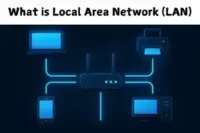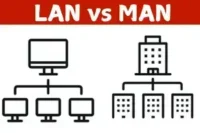Advantages and Disadvantages of Linear Bus Topology
Published: February 7, 2025
Is linear bus topology still relevant in modern networking? While it was once a popular choice for small networks, its limitations make it less common today. It offers affordability and easy setup, but issues like signal degradation and troubleshooting challenges raise concerns. Should you use it or opt for a more advanced network topology? Let’s explore the advantages and disadvantages of linear bus topology to help you decide.

What is Linear Bus Topology?
Linear bus topology is a network setup where all devices are connected to a single backbone cable, with data traveling in both directions. It is simple and cost-effective but has a single point of failure, meaning the entire network goes down if the main cable breaks.
Linear Bus Topology Advantages and Disadvantages
Linear Bus Topology offers benefits and challenges, making evaluating its strengths and limitations crucial before implementation.

Advantages of Linear Bus Topology
Linear bus topology has several benefits, especially for small networks and cost-conscious environments. While it is not as popular as newer networking structures, it is still helpful in specific cases. Here are its key advantages:
✅ Cost-Effectiveness
✅ Simple Setup and Installation
✅Scalability for Small Networks
✅ Suitable for Temporary Networks
✅ Efficient for Limited Traffic
Let’s break down how it can make tasks more manageable for us.
1. Cost-Effectiveness
One of the biggest reasons organizations use linear bus topology is its low cost.
- It requires less cable than star, mesh, or hybrid topologies.
- No need for expensive networking hardware like switches or hubs.
- Installation and maintenance are cheaper, making it ideal for small businesses or temporary networks.
For example, a small office with five computers can connect all devices using a single coaxial cable without investing in additional networking infrastructure.
2. Simple Setup and Installation
Linear bus topology is easy to install due to its simple design.
- It consists of a single cable, so there’s no need for complex wiring.
- Since all devices share the same backbone, installation time is reduced.
- Minimal technical expertise is required, making it a good choice for quick deployments.
For instance, if a school wants to set up a computer lab, a linear bus network can be installed without additional networking equipment.
3. Scalability for Small Networks
Although linear bus topology is not ideal for large networks, it works well for small-scale environments.
- New devices can be easily added without changing the overall structure.
- No need to reconfigure the network when adding extra computers.
For example, a startup with five employees can start with a basic linear bus network and add more computers as the business grows.
4. Suitable for Temporary Networks
Sometimes, organizations need temporary networks for short-term projects. Linear bus topology is perfect for these situations.
- Used in construction sites where temporary offices need basic networking.
- Ideal for events and conferences where network setup is required only for a few days or weeks.
- It can be quickly removed after use.
For example, a music festival that requires internet access for ticketing and communication can set up a linear bus network without investing in permanent infrastructure.
5. Efficient for Limited Traffic
Linear bus topology performs well in low-traffic environments, such as:
- Small offices where only a few computers need to communicate.
- Home networks where essential file sharing and internet access are required.
- Research labs with minimal data transfer.
Data collisions are minimal in these cases, and the network remains stable.
Disadvantages of Linear Bus Topology
Despite its advantages, linear bus topology has significant drawbacks that limit its usage in modern networking. Here are some of its major disadvantages:
❌ Single Point of Failure
❌ Performance Issues with More Devices
❌ Limited Cable Length
❌ Difficult Troubleshooting
❌ Security Concerns
In this section, we’ll discuss the pros and cons of linear bus topology in detail so you can make an informed decision.
1. Single Point of Failure
The biggest flaw of linear bus topology is that it has a single point of failure.
- If the main bus cable breaks, the entire network goes down.
- All connected devices lose communication until the cable is repaired.
- Finding and fixing the issue can be time-consuming.
For example, if a technician accidentally cuts the main cable in a corporate office, all computers will immediately lose network access.
2. Performance Issues with More Devices
As more devices are added to the network, performance decreases.
- More devices mean higher data traffic, increasing the chances of collisions.
- Data collisions slow down communication, leading to delays.
- The network becomes less efficient in handling multiple requests.
For example, in a busy internet café, the network speed slows down significantly if too many users are downloading files simultaneously.
3. Limited Cable Length
Linear bus topology has physical limitations in terms of cable length.
- Each network has a maximum bus length (e.g., 500 meters for coaxial cables).
- If the cable is too long, signal degradation occurs.
- Repeaters are needed to extend the network, but they add extra cost and complexity.
For example, a university that wants to connect multiple buildings using a linear bus topology will face signal loss issues over long distances.
4. Difficult Troubleshooting
Since all devices share the same cable, locating faults is challenging.
- If one device malfunctions, it can affect the entire network.
- Cable damage is hard to pinpoint because multiple devices rely on the same backbone.
- The network must be physically checked to find the problem.
For instance, if a company’s accounting department suddenly loses network access, IT staff must inspect the entire cable to find the source of failure.
5. Security Concerns
Linear bus topology has poor security, making it vulnerable to cyber threats.
- Any device connected to the bus can intercept network traffic.
- There is no encryption, so hackers can easily capture sensitive data.
- Unauthorized users can gain access if they connect to the main bus cable.
For example, if someone connects a sniffing device to the bus cable in a shared workspace, they can monitor and steal confidential information.
Comparison Between Advantages and Disadvantages of Linear Bus Topology
Here’s a comparison table showing the advantages and disadvantages of linear bus topology:
| Advantages ✅ | Disadvantages ❌ |
| Cost-effective – Requires less cable and no extra hardware like switches. | Single point of failure – If the main cable breaks, the entire network fails. |
| Easy to install – Simple setup with minimal wiring. | Difficult troubleshooting – Finding faults requires checking the entire cable. |
| Best for small networks – Works well for limited devices and traffic. | Limited scalability – Adding too many devices slows down the network. |
| Temporary setup-friendly – Ideal for short-term networks like construction sites. | Performance issues – Increased traffic can lead to data collisions. |
| No dependency on a central hub – Reduces hardware failure risks. | Low security – Any connected device can access the transmitted data. |
Conclusion
The advantages and disadvantages of linear bus topology highlight its strengths and weaknesses. While it may not be the most advanced networking solution, its simplicity and affordability make it an option worth considering for specific setups. Understanding your network’s needs and scalability is the key to choosing the proper topology. No network is perfect, but you can build a system that meets your goals appropriately. Keep exploring and experimenting to find what works best for you!
FAQS About Advantages and Disadvantages of Linear Bus Topology
Linear bus topology is not as common today because modern networks use more reliable designs like star or mesh topology. However, it is still used in small offices, temporary setups, and simple networks where cost and ease of installation are priorities.
Since all devices connect to a single backbone cable, any break in the cable disconnects the entire network. Unlike a star topology, which has a central hub, a bus topology does not have a backup connection.
Yes, it is cheaper because it requires less cable and does not need expensive hardware like switches or hubs. However, troubleshooting and maintenance costs can increase in the long run if network failures occur.
No, linear bus topology is not ideal for large networks because as more devices connect, the network becomes slower and prone to data collisions. It works best for small-scale setups with minimal traffic.
Too many devices can cause congestion, leading to slower data transfer and more collisions. This makes the network inefficient, especially when multiple devices try to communicate simultaneously.
Troubleshooting can be challenging because if there is a problem, you have to check the entire cable to find the issue. Unlike star topology, where you can isolate a faulty device quickly, finding errors in a bus network takes more time.
Security is a significant concern in linear bus topology because all devices share the same transmission path. If one device is compromised, all data flowing through the network can be intercepted without much effort.
Linear bus topology is cheaper and easier to set up because it does not require a central hub or extra hardware. However, star topology is more reliable because if one device fails, the rest of the network keeps working.
Typically, coaxial cable is used for linear bus topology, but twisted pair cables can also be used in some cases. However, the length of the cable is limited, and signals may weaken over long distances.
The biggest risk is the single point of failure—if the backbone cable breaks, the entire network stops working. This makes it less reliable than other network topologies that have redundant connections.





